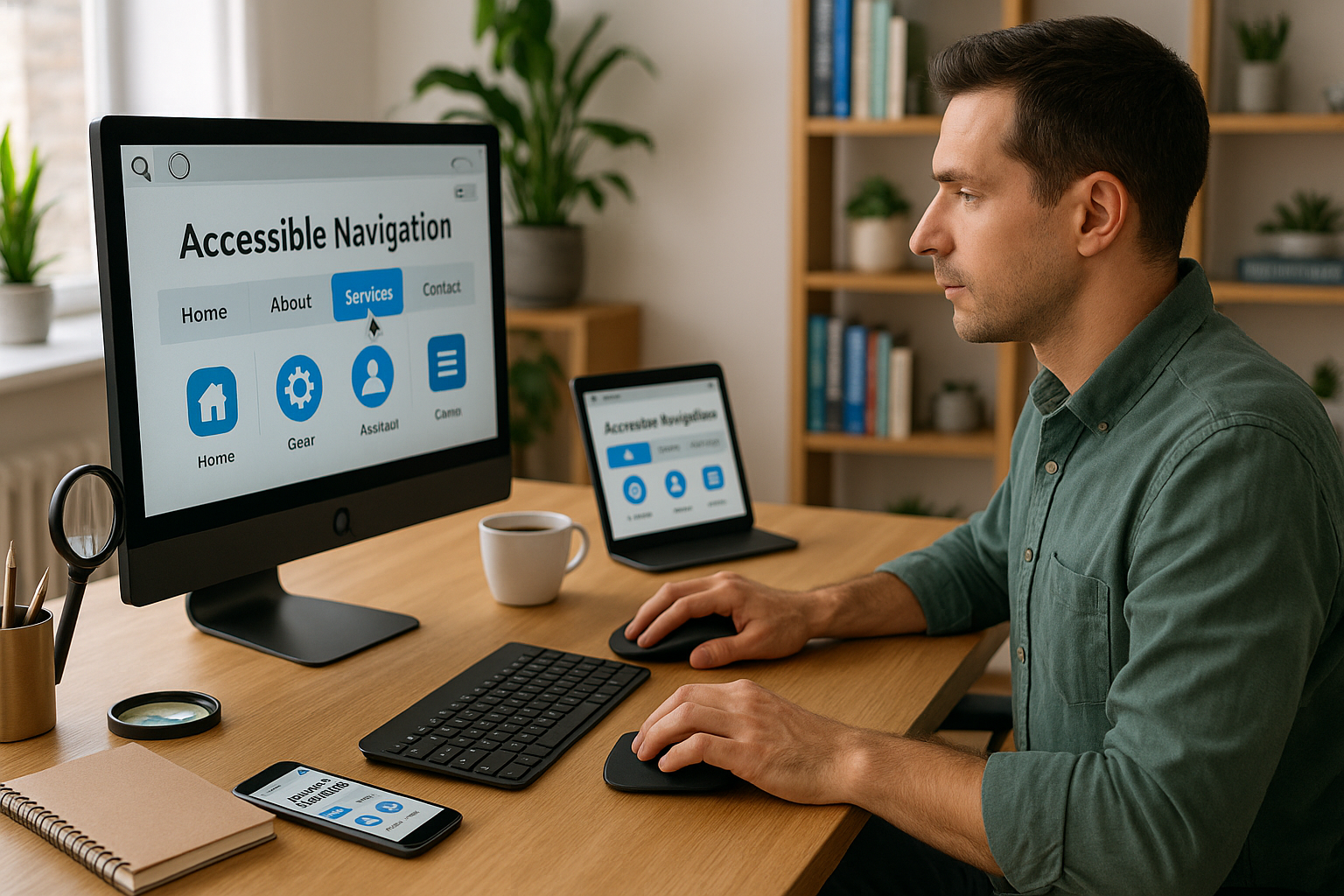Our reliance on navigation is undeniable. It’s the difference between an intuitive, effortless online journey and a frustrating digital maze. Today’s conversation orbits around one vital aspect of web development: constructing an accessible navigation menu that caters to all users. 🌐
The intersection of technology and design has enabled us to craft more user-centric digital environments. However, a critical component of user interface design, the navigation menu, is often overlooked, hindering seamless user experience. Our goal with this comprehensive guide is to unlock the secrets to creating a navigation menu that is not only functional and intuitive but also accessible to all users, irrespective of their abilities or the devices they use. 🚀
Why the Focus on Accessibility?
Accessibility is no longer a mere afterthought in the web development sphere. It has taken center stage, with an increased awareness of the need for digital inclusivity. As the Internet continues to shape our daily lives, the importance of creating a navigation menu that is equally accessible to all users—be they fully-abled, differently-abled, using desktops, tablets, or smartphones—cannot be overstated. 💡
By making your navigation menu accessible, you are not only meeting legal requirements and ethical standards, but also enhancing your website’s usability, potentially expanding your user base, and improving your SEO ranking.📈 The need for a guide that lays out the blueprint for building an accessible navigation menu has never been greater. This guide is designed to serve just that purpose.
What Awaits You in This Guide?
But, what does it take to build an accessible navigation menu? In this extensive guide, we will dissect this question piece by piece, delving into the specifics of user interface design, web accessibility standards, and responsive design techniques.
Our discourse will begin with a brief overview of web accessibility and why it is crucial in the contemporary digital landscape. We will then venture into the mechanics of navigation menus, their types, their role in user interface design, and the common pitfalls in their construction.🔧
Next, we’ll turn our attention to the various techniques for building an accessible navigation menu, shedding light on the importance of keyboard accessibility, semantic HTML, ARIA landmarks, and more. We will also explore how to make your navigation menu responsive, ensuring it works smoothly on any device.
Finally, we will discuss how to test your navigation menu’s accessibility, providing you with an arsenal of tools and techniques to ensure your menu doesn’t just look good, but is also functionally optimal and inclusive.💼
Regardless of whether you’re a seasoned developer wanting to refresh your knowledge, a newbie seeking to learn the ropes, or a curious reader with a penchant for web design, this guide promises to be a valuable resource. So let’s embark on this enlightening journey of unlocking seamless navigation and championing digital accessibility for all! 🎯
Discovering the Art of Building Accessible Navigation Menus
In the ever-evolving world of technology, creating an accessible navigation menu is no longer an option but a necessity. As we strive to make the digital space more inclusive, understanding how to build a nav menu that is accessible to all users, irrespective of their abilities, becomes crucial. As a developer, your role transcends beyond coding to ensuring that each user’s experience on your website is seamless and satisfying.
The challenge, however, lies in understanding what accessibility means and how it impacts the navigation menu. Herein, we will delve into the intricacies of accessible navigation menus, illuminating the path towards creating an all-inclusive digital experience. Grab your developer hat as we embark on this journey!
Before we proceed, take a moment to grasp the concept of web accessibility through the video “Web Accessibility Tutorial – Learn How to Make Your Website Accessible” by LearnWebCode on YouTube.
What is Web Accessibility?
Web Accessibility refers to the practice of making your website accessible to all users, including those with disabilities. It involves designing and developing a website that accommodates all kinds of users, allowing them to perceive, understand, navigate, and interact with the web.
Understanding the Importance of an Accessible Nav Menu
The navigation menu is one of the most critical components of your website. It is the roadmap to your site, guiding users to the information they seek. Hence, ensuring that your nav menu is accessible to all, including those with disabilities, directly impacts user experience and satisfaction.
Accessible navigation menus cater to a wider range of users, including those using assistive technologies like screen readers. They also help in enhancing SEO, as search engines prioritize websites that are accessible and user-friendly.
As we dive deeper into this subject, take a look at this comparative table of accessible versus inaccessible nav menus.
| Accessible Nav Menu | Inaccessible Nav Menu |
|---|---|
| Has clear, descriptive labels | Has vague, unclear labels |
| Offers keyboard accessibility | Lacks keyboard accessibility |
| Compatible with screen readers | Incompatible with screen readers |
Key Steps to Building an Accessible Nav Menu
Now that we have understood the importance of an accessible nav menu, let’s take a look at how to build one. This process involves a series of steps that require careful consideration and execution.
Before we dive into these steps, take a moment to watch “How to Create an Accessible Website Menu” by Equal Entry on YouTube for an in-depth explanation of the process.
Label Your Menu Items Clearly
First and foremost, each item on your navigation menu should have a clear and descriptive label. These labels should provide a clear idea of what the user can expect upon clicking on them. Unclear or ambiguous labels can confuse users, especially those using screen readers, and impede the navigation process.
Ensure Keyboard Accessibility
Not all users navigate websites using a mouse. Some, particularly those with motor disabilities, use the keyboard to navigate. Hence, ensuring that your navigation menu is keyboard accessible is crucial. This involves making sure that all interactive elements of your menu are accessible through the Tab key and can be activated using the Enter key.
Make It Screen Reader Friendly
A significant portion of users with visual impairments use screen readers to navigate the web. Therefore, making your navigation menu compatible with screen readers is imperative. This involves using the correct HTML tags and ARIA roles, and providing alternative text for images.
The Role of Testing in Ensuring Accessibility
The journey towards building an accessible nav menu doesn’t end with development. Testing is a critical part of the process to ensure that your menu is truly accessible to all users.
There are several tools available for testing web accessibility, including WAVE, Accessibility Insights, and Google’s Lighthouse. These tools can help you identify any accessibility issues in your nav menu and provide recommendations on how to fix them.
Additionally, consider involving users with disabilities in your testing process. Their insights can help you understand how accessible your nav menu is in a real-world scenario and make necessary adjustments.
Embrace Feedback and Keep Improving
Remember, building an accessible nav menu is an ongoing process. As technology and user needs evolve, so should your navigation menu. Embrace feedback from your users, keep testing and tweaking your menu, and continue learning about web accessibility. This commitment to accessibility will not only make your website more user-friendly but also contribute to a more inclusive digital space. And isn’t that a goal worth striving for?
So, let’s get started on building an accessible nav menu. Take a step towards inclusivity and let’s make the digital world accessible to all!

Conclusion
As we reach the conclusion of this article, I hope that the technical depth and extensive detail presented have provided you with a comprehensive understanding of our central topic. Over the course of this discourse, we have delved into the intricate realms of Information Technology (IT) and engineering, breaking down complex concepts into more digestible bits of information.
Firstly, we began our journey with a detailed exploration of the basic principles underpinning the domain we’ve been discussing. The fact is, understanding the fundamental aspects of any topic is the key to mastering its more intricate elements, hence our initial focus on these basic principles. In my many years of writing technical content, I have always made a concerted effort to explain these fundamental principles in an accessible and user-friendly manner. 🧐📚
In the middle section of this article, we dove deeper into the core concepts, demonstrating how they are applied in real-world scenarios. This is where the true essence of our subject matter comes to life, as theory is transformed into practice. These insights were aimed at providing you with a practical understanding of how to implement these principles. 💡🌐
Furthermore, we explored some of the common challenges faced when dealing with these concepts, and provided practical solutions based on my experience and expertise. The objective here was not to shy away from the challenges but to face them head-on, learning and growing in the process. It’s always important to remember that challenges are not roadblocks, but stepping stones to success. 🚀🔧
Finally, we examined the future prospects and potential developments in this field. In the ever-evolving landscape of technology and engineering, it’s important to stay ahead of the curve and remain informed about the latest trends and innovations. Therefore, this segment aimed at keeping you updated and ready for what the future holds. ⏭️🔮
I trust that you have found this exploration insightful, informative and practical. The importance of this topic cannot be overstated. If properly understood and implemented, these principles can provide a significant boost to your technical acumen and professional growth. 💼💡
Feel free to share this article with your colleagues and friends who might find it beneficial. Engage in the comment section below and share your thoughts, experiences and queries on the topic. I look forward to hearing your perspectives and engaging in stimulating discussions. 👥💬
Remember, knowledge is power. The more we share, the more we learn, and the more we grow. So, keep exploring, keep learning and keep sharing. 🌐🎓
For further study, you may consider these sources which have been instrumental in the development of this article:
Remember, it’s not the destination, but the journey that matters. Here’s to a lifelong journey of learning! 🚀🎓



